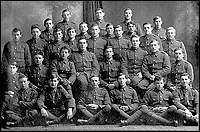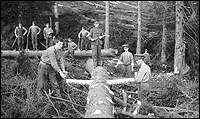|


|

|

Forestry Corps
In March 1917, Prime Minister Sir Edward Morris first entertained the idea of forming the
Newfoundland Forestry Corps. A year earlier, in the summer of 1916, Canada had sent overseas a forestry
contingent of approximately 22,000 men.
Group photo of Forestry Corps, ca. 1917.
Courtesy of the Heritage Society of Grand Falls-Windsor, Grand Falls-Windsor, Newfoundland.
 (53 Kb)
(53 Kb)
|
 |

|
With the organizational assistance of Governor Sir Walter Davidson and the
Newfoundland Patriotic Association, a crew of 498 foresters enlisted to work in the
United Kingdom. An additional 278 failed to meet the physical requirements. The British
government agreed to pay the cost of maintaining the corps. A large proportion of the Corps were from
central Newfoundland, workers from the Anglo-Newfoundland Development (AND)
Company in Grand Falls and the Albert E. Reed Company in Bishop’s Falls.

|
 |
Forestry Corps working in forests of Scotland, ca. 1917.
Courtesy of the Heritage Society of Grand Falls-Windsor, Grand Falls-Windsor, Newfoundland.
 (56 Kb)
(56 Kb)
|
Newfoundland sawmill in Craigvinean, Scotland, n.d.
Courtesy of the Heritage Society of Grand Falls-Windsor, Grand Falls-Windsor, Newfoundland.
 (42 Kb)
(42 Kb)
|
 |

|
Once in the United Kingdom, the Newfoundlanders earned themselves an enviable
reputation. Near the Scottish town of Craigvinean they erected a 3,000-foot
timber chute to move logs over difficult terrain to the mills. The local Timber Supply Department
of the Board of Trade later remarked that the chute would “long be remembered as marking an
epoch in forest utilization in Scotland” (Smallwood 447).

|

|
 |